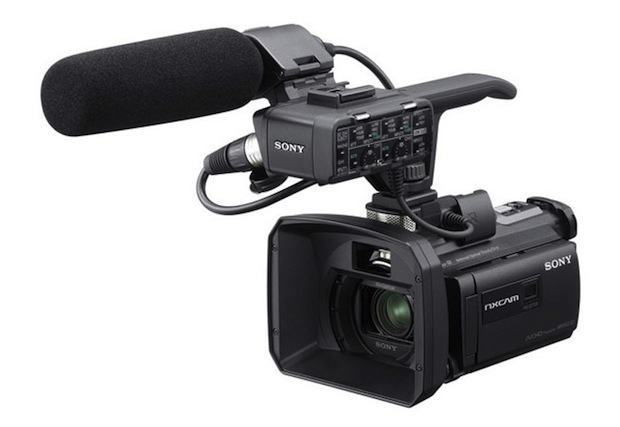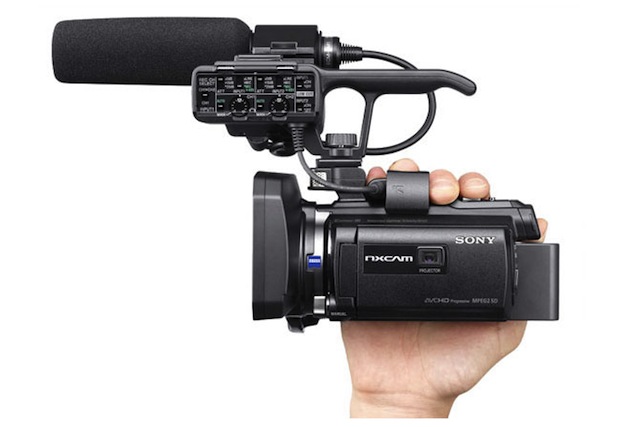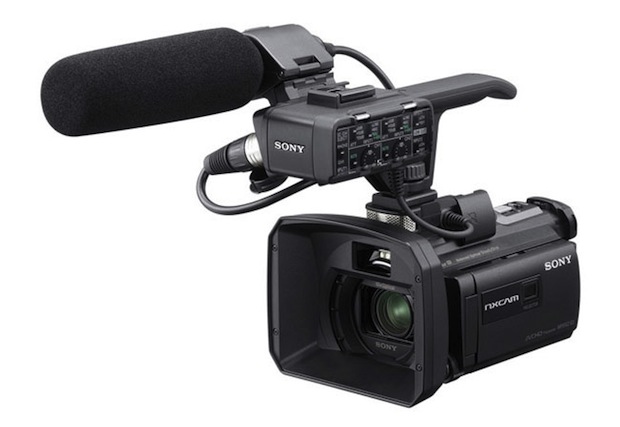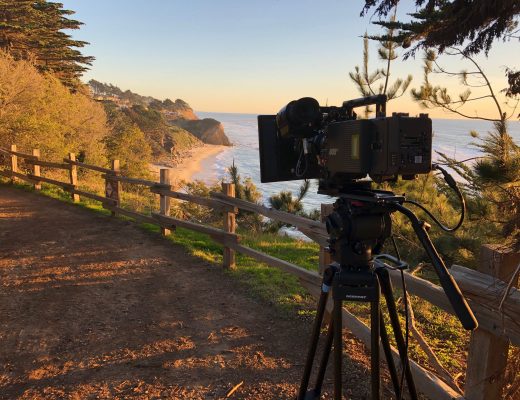
Although during the past year I’ve written quite a bit about the Sony NX70 (officially, the HXR-NX70) here in ProVideo Coalition magazine, I haven’t yet published my review on it because I only received the NX70 loaner unit yesterday. While I prepare the review of the NX70 in the next couple of weeks, I feel compelled to let you know that at NAB 2012, Sony quietly announced the NX30 (HXR-NX30), a little sister (i.e. smaller and lower cost) to the NX70 which apparently shares the same sensor and almost identical specs on its lens. From my perspective, the NX30 is clearly focused by Sony to overtake the market space currently occupied by the Canon XA10 and the Panasonic AG-HMC40 (price/size/progressive/electric zoom/balanced audio inputs), about which I’ve already written a few times. In this first look at the NX30, I’ll highlight the NX30’s unique characteristics, make some initial observations & comparisons, and include some videos about it.
Defining the market space
Very few HD video camcorders under US$2500 list price (under US$2000 street price) offer the combination of:
- Progressive recording
- Balanced microphone inputs
- Electrically-controlled zoom lens
Before the NX30 from Sony, to my knowledge the only two cameras that covered that particular market space were the Canon XA10 and the Panasonic AG-HMC40. Of course, an electrically-controlled zoom lens is not for everyone. Some videographers demand an electrically-controlled zoom lens, while others -some of whom consider themselves to be digital filmmakers- avoid a camera with an electrically-controlled zoom lens in favor of a camera with a much larger sized sensor and removable prime lenses or manual zoom lenses. And of course, some videographers are interested in both categories of cameras for different applications, as am I.
It should be noted that with the AG-HMC40 (reviewed by Adam Wilt in 2009), the balanced XLR input is an optional accessory offered by Panasonic at extra cost, while with both the Canon XA10 and the Sony NX30, this feature -while removable- comes standard, at no extra cost.
Basic specs of the NX30

At least at its introduction, the NX30 is a segregated professional AVCHD camcorder which features a larger-than-typical sensor for its market space (as described above). While the Panasonic AG-HMC40 has a very small 1/4.1-inch sensor, the Canon XA10 has a larger 1/3-inch sensor, and the NX30 has an even larger 1/2.88-inch Exmor R sensor. The sensor in all three is some type of CMOS. Although the AG-HMC40 (the oldest of the three referenced cameras) uses a 3MOS sensor and the other two cameras use a single CMOS sensor, having a sensor per primary color is no longer considered a must-have to achieve high-quality, and some cameras that are multiple times more expensive use this approach nowadays.
Advantages of this larger sensor
Beyond the potential better sensitivity and other benefits (including making it easier to reduce depth-of-field when desired), the larger sensor can offer a wider widest angle with the same lens (without having to resort to the cost and complication of a wide angle adapter or converter). At their respective 35mm equivalents:
- The Panasonic AG-HMC40 (with the smallest sensor at 1/4.1-inch) offers a widest wide angle of 40.8mm (35mm equivalent).
- The Canon XA10 (with a larger sensor at 1/3-inch) offers a widest wide angle of 30.4mm (35mm equivalent).
- The Sony NX30 (with an even larger 1/2.88-inch) offers a widest wide angle of 26mm (35mm equivalent).
So if you value very wide angle shooting, the NX30 is the strongest of the three referenced cameras. Of course, if you favor telephoto, the advantage is in the opposite direction, since the maximum telephoto at their respective 35mm equivalents are:
- The Sony NX30 offers a maximum telephoto of 260mm (35mm equivalent).
- The Canon XA10 offers a maximum telephoto of 305mm (35mm equivalent).
- The Panasonic AG-HMC40 offers a maximum telephoto of 490mm (35mm equivalent).
However, most people I know prefer to favor the wider wide angle in this type of a camera for several reasons.
In versions typically sold in 60Hz countries, the NX30 will offer the same framerates as its bigger sister the NX70 in those areas (after the NX70 received its recent firmware update):
- 1080/23.976p (presumably native)
- 1080/29.97p (presumably benign PsF)
- 1080/59.94p
- 1080/29.97i (previously called 59.94i)
- 720/59.94p
On the other hand, versions typically sold in 50Hz countries will offer the same framerates as its bigger sister the NX70 in those areas:
- 1080/25p (presumably benign PsF)
- 1080/50p
- 1080/25i (previously called 50i)
- 720/50p
The ones I marked “presumably” is based upon prior experience with other NXCAM models. However, i will confirm them when I publish my final review once the NX30 ships.
The terms benign PsF and malignant PsF were defined in part 1 of the PsF’s missing workflow series, which as of today has reached part 10 and continues…
Ed Moore gives his first impressions of the NX30
Interesting features of the NX30
- 96GB internal memory
- Slot for either SD card or Sony Memory Stick
- Permanently attached USB cable (yet hidden when not in use)
- Balanced Optical SteadyShot w/FIXED SHOT mode (SteadyShot is a Sony trademark for an integrated video camera image stabilization technology developed by Sony for its range of consumer and prosumer video camcorders.)
- Nightshot mode
- Built-in light to illuminate your subject
- Built-in projector (more details to be provided in the final review of the NX30)
Sony’s musical video promoting the 59.94Hz version of the NX30
It’s not my style of music, but it shows the camera’s features well 
To make sure you continue to see my upcoming articles, sign up to my mailing list here.
Allan T©pper’s policy on model nomenclature
Since I know we have an international audience and we are living in the global village (thanks Marshall McLuhan!), when I mention model numbers, I deliberately omit regional suffixes when they make absolutely no difference in a product’s features or functionality worldwide. I include these suffixes only when making specific reference to differences among regional variants. So if you see a model number I mention and you are used to seeing that same model number with an “E”, “J”, “N”, “U”, or “P” suffix, what I am writing is applicable to any version, with any suffix. Those few times I do include the suffix, it’s because I am specifically describing features which are specifically added or missing from that version of the product. I encourage all journalists in all media to do the same. I am constantly researching the possible variants among model numbers in the international marketplace. Often, video equipment manufacturers restrict certain functionality in regional versions, and sometimes they use a strict regional warranty system. Sometimes the manufacturers do this to avoid grey marketing (i.e. to encourage purchasing of products in a local region, to protect local distribution), and sometimes it’s to avoid extremely high import tariffs in a specific market. When they do this, the manufacturers often add a regional suffix to the model number.
Allan T©pper’s books, consulting, articles, seminars & audio programs
Contact Allan T©pper for consulting, or find a full listing of his books, articles and upcoming seminars and webinars at AllanTepper.com. Listen to his TecnoTur program, which is now available both in Castilian (aka “Spanish”) and in English, free of charge. Search for TecnoTur in iTunes or visit TecnoTur.us for more information.Disclosure, to comply with the FTC’s rules
No manufacturer is specifically paying Allan T©pper or TecnoTur LLC to write this article. Some of the other manufacturers listed above have contracted T©pper and/or TecnoTur LLC to carry out consulting and/or translations/localizations/transcreations. Many of the manufacturers listed above have sent Allan T©pper review units. So far, none of the manufacturers listed above is/are sponsors of the TecnoTur programs, although they are welcome to do so, and some are, may be (or may have been) sponsors of ProVideo Coalition magazine. Some links to third parties listed in this article and/or on this web page may indirectly benefit TecnoTur LLC via affiliate programs.
Copyright and use of this article
The articles contained in the TecnoTur channel in ProVideo Coalition magazine are copyright Allan T©pper/TecnoTur LLC, except where otherwise attributed. Unauthorized use is prohibited without prior approval, except for short quotes which link back to this page, which are encouraged!

Filmtools
Filmmakers go-to destination for pre-production, production & post production equipment!
Shop Now













